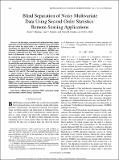Blind Separation of Noisy Multivariate Data Using Second-Order Statistics: Remote-Sensing Applications
Author(s)
Mueller, Amy V.; Herring, Keith T.; Staelin, David H.
DownloadHerring_Blind-Separation.pdf (1.032Mb)
PUBLISHER_POLICY
Publisher Policy
Article is made available in accordance with the publisher's policy and may be subject to US copyright law. Please refer to the publisher's site for terms of use.
Terms of use
Metadata
Show full item recordAbstract
In this paper a second-order method for blind source separation of noisy instantaneous linear mixtures is presented for the case where the signal order k is unknown. Its performance advantages are illustrated by simulations and by application to Airborne Visible/Infrared Imaging Spectrometer (AVIRIS) multichannel visible/infrared data. The model assumes that m mixtures x of dimension n are observed, where x = Ap + Gw, and the underlying signal vector p has k < n/3 independent unit-variance elements. A is the mixing matrix, G is diagonal, and w is a normalized white-noise vector. The algorithm estimates the Second-Order separation matrix A, signal Order k, and Noise and is therefore designated as SOON. SOON first iteratively estimates k and G using a scree metric, singular-value decomposition, and the expectation-maximization algorithm, and then determines the values of AP and W. The final step estimates A and the set of m signal vectors p using a variant of the joint-diagonalization method used in the Second-Order Blind Identification (SOBI) and Second-Order NonStationary (SONS) source-separation algorithms. The SOON extension of SOBI and SONS significantly improves their separation of simulated sources hidden in noise. SOON also reveals interesting thermal dynamics within AVIRIS multichannel visible/infrared imaging data not found by noise-adjusted principal-component analysis.
Date issued
2009-09Department
Massachusetts Institute of Technology. Department of Civil and Environmental Engineering; Massachusetts Institute of Technology. Department of Electrical Engineering and Computer Science; Massachusetts Institute of Technology. Research Laboratory of ElectronicsJournal
IEEE Transactions on Geoscience & Remote Sensing
Publisher
Institute of Electrical and Electronics Engineers
Citation
Herring, K.T., A.V. Mueller, and D.H. Staelin. “Blind Separation of Noisy Multivariate Data Using Second-Order Statistics: Remote-Sensing Applications.” Geoscience and Remote Sensing, IEEE Transactions on 47.10 (2009): 3406-3415. © 2009 IEEE
Version: Final published version
ISSN
0196-2892
Keywords
separation, remote sensing, image representation, estimation, Blind signal separation (BSS)